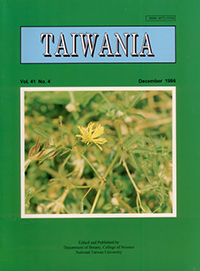Research Paper
Pollination Ecology of the Endangered Eremostachys Superba
Arti Garg and R. R. Rao
Published on: December 1996
Page: 309 - 321
DOI: 10.6165/tai.1996.41.309
Abstract
Pollination ecology of Eremostachys superba (Labiatae) from the Siwaliks of Uttar Pradesh, India, is discussed. The low population strength was found to be responsible for pollinator limitation in the species. This species is adapted for cross-pollination by oligolectic pollinivorous bees, Nomia rustica and Ceratina heiroglyphica of the order Hymenoptera. The bees were pollinivorous and eutropic in nature and exhibited floral fidelity behaviour while foraging for pollen. Their visitations to the flowers were ethodynamic, but scanty. The flowers, in turn, were oligophilic and pollination mechanism was sternotribic. A specialised plant-pollinator coadaptation existed in this critically endangered species which is exposed to a high reproductive bottleneck.
中文摘要
本文討論產於印度之Siwaliks, Uttar Pradesh地區的唇形科(Labiatae)植物:印度沙穗(Eremostachys superba Royle ex Benth)的傳粉生態學。本植物因傳粉者的限制,反映其脆弱的族群強度。印度沙穗具有適應兩種少食性傳粉蜂:Nomia rustica West.和Ceratina heiroglyphica Sm.之他花傳粉,兩者皆屬膜翅目(Hymenoptera)昆蟲。在自然界中蜂類具有傳粉和依陽光判定方向的能力,並且在找尋及收集花粉時具有對花的忠誠性,採訪花時是群體而非個別行動的。另外本植物花為昆蟲專一性,其傳粉機制為膜版媒的(sternotribic)。對一瀕臨絕種的植物而言,是否有特化的植物傳粉者的共同演化才是其生殖瓶頸。 關鍵詞:印度沙穗,昆蟲動態,昆蟲專一性花,傳粉生態學,傳粉者,膜版媒機制
Keyword: Eremostachys superba, ethodynamic, monolectic oligo-philic, pollination, ecology, pollinators, sternotribic


